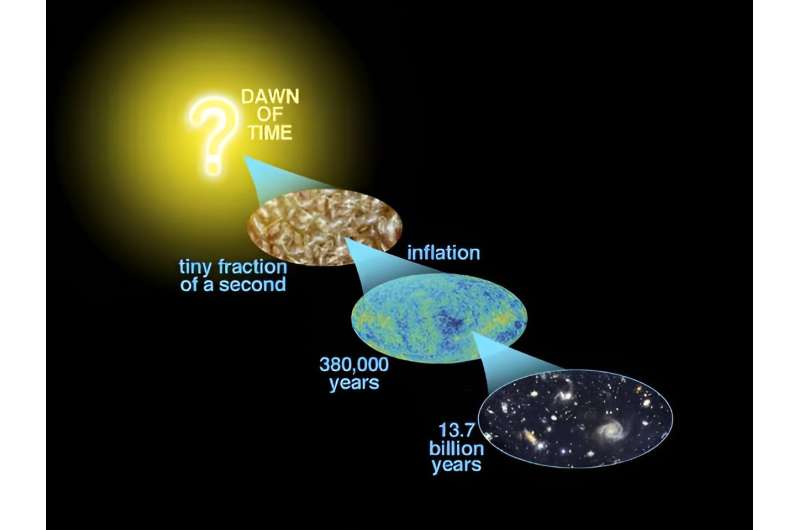This article has been reviewed according to Science X's editorial process and policies. Editors have highlighted the following attributes while ensuring the content's credibility:
fact-checked
preprint
trusted source
proofread
The echoes from inflation could still be shaking the cosmos today

In the very early universe, physics were weird. A process known as inflation, during which the universe went from a single infinitesimal point to everything we see today, was one such instance of those weird physics. Now, scientists from the Chinese Academy of Science have sifted through 15 years of pulsar timing data in order to put some constraints on what physics looks like.
The 15 years of data come from the North American Nanohertz Observatory for Gravitational Waves or NANOGrav. NANOGrav's goal is to use an unconventional way to detect gravitational waves—by looking at pulsars. These fast-spinning objects are commonly used as "clocks" in astronomical terms.
Back in 1983, a pair of astronomers (Ronald Hellings and George Downs) developed a method by which astronomers could use an array of these pulsars to check for shifts that gravitational waves might cause.
More recent work has seen pulsar timing arrays (PTAs) such as NANOGrav successfully identify a specific flavor of gravitational wave known as the stochastic gravitational wave background (SGWB). The SGWB is similar in concept to the cosmic microwave background—a consistent glow from the early universe that astronomers can see as a series of microwaves coming from all directions at once.
In the case of SGWB, gravitational waves are coming from all directions at once rather than microwaves. And their warping of space-time is detectable if astronomers watch the right pulsars closely enough. Some of the sources of that warping go all the way back to the universe's inflationary period.
One particular version of inflation seems to fit the SGWB model well. Known as "ultra-slow-roll" (USR) inflation, this type of inflation had to fight against the forces of friction in the early universe, and the result is a series of clumped matter that is the source of the SGWB signals that NANOGrav and other pulsar timing array experiments are seeing.
However, there are potentially other explanations for where that signal source might be coming from. In particular, the idea of an in-spiraling supermassive black hole binary has been put forward as another potential source for the PTAs' findings.
Bo Mu and his colleagues at the Chinese Academy of Sciences published a paper on the pre-print server arXiv that seems to have answered the question of where the background gravitational waves are coming from.
To do so, they used around 15 years of data produced by NANOGrav and collected at the consortium's telescopes. According to the paper, the expected waves from USR inflation fit the data collected over that long period better than the black hole binaries or another concept known as the "bubble collision of the cosmological phase transition."
Fitting data to models is some of the most critical work in the theoretical physics community. This paper is a step in the right direction of understanding the new physics of gravitational waves. Assuming it makes it through the peer review process, it's likely to be followed by numerous others, like detailing where the background of this wonderful world of newly discovered gravitational waves comes from.
More information: Bo Mu et al, Constraints on ultra-slow-roll inflation with the NANOGrav 15-Year Dataset, arXiv (2023). DOI: 10.48550/arxiv.2310.20564
Journal information: arXiv
Provided by Universe Today



















